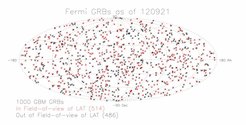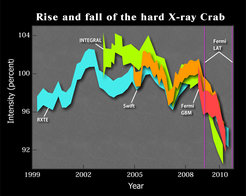
The gamma-ray burst monitor (GBM) instrument on Fermi detected its 1000th gamma-ray burst today! This figure from Valerie Connaughton shows the location on the sky of these 1000 cosmic explosions.

X-ray data from NASA's Fermi, RXTE, and Swift satellites and the European Space Agency's International Gamma-Ray Astrophysics Laboratory (INTEGRAL) confirm that the Crab Nebula's output has declined about 7 percent in two years at energies from 15,000 to 50,000 electron volts. They also show that the Crab has brightened or faded by as much as 3.5 percent a year since 1999. Fermi's Large Area Telescope (LAT) has detected powerful gamma-ray flares (magenta lines) as well.
Image credit: NASA's Goddard Space Flight Center

While Fermi flew over Egypt, the GBM intercepted a particle beam from a terrestrial gamma-ray flash (TGF) that occurred in a thunderstorm below its horizon.
Credit: NASA/Goddard Space Flight Center


